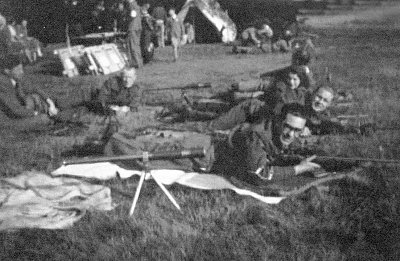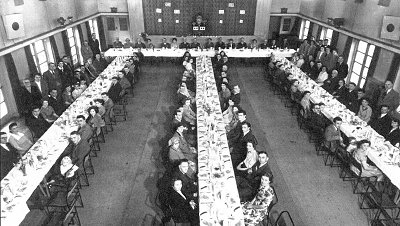COMPETITIVE RIFLE SHOOTING IN WOLVERHAMPTON FROM 1945by Frank Spittle2. Shooting in and around Wolverhampton after 1945At the end of the great conflict involving both civilians and servicemen, the vast majority of both had, in some way, been introduced to that personal arm, the rifle. Home Guard units in the Wolverhampton area, having enjoyed the camaraderie of training and shooting together for such a considerable time, were loathe to give up what quite a few had enjoyed: shooting against each other in competition. Membership, ammunition, and ranges were still free to anyone still wishing to join the Home Guard or Territorial Army. Rifles of both calibres, 303 and 22, were still available in the armouries of the T A centres and Home Guard units that were still functioning. Range space was not a problem for the indoor shooters using the 22 rifle. Chubbs, GKN, Goodyear, Stewart and Lloyds, and several other factories in the area had constructed rifle ranges close to the workshops for the convenience of their part time soldiers. These were put to good use by an influx of returning service people with the smoke of battle still in their nostrils, who wished now to have the luxury of throwing bullets forward without the inconvenience of receiving some back by reply. Soon the Home Guard clubs were joined by civilian clubs and other industrial shooters, as the service side declined and the civilian side grew. However, it was the initiative of half dozen or so members of the Wolverhampton and District Home Guard, who represented some of the local unit rifle clubs, who could see that, if shooting was to continue competitively now the war had ended, some form of organisation would be necessary to run competitions, events and leagues. On the 30th of December 1947, seven of these shooters met for their first General Meeting at the George Hotel, Stafford Street, Wolverhampton. Their declared object was that "The Wolverhampton and District Rifle League shall promote essentially shoulder to shoulder matches between teams for Rifle Clubs in and around Wolverhampton with a view to improving the general standard of marksmanship in the district". At this meeting were Mr. Cliff Everall, 22nd Bn. Staffs H.G.; Mr Arthur Haynes, Wolverhampton Special Police; Mr. W .D. McCourly and Mr Frank Collins, 23rd Bn. Staffs Home Guard; Mr. F. Fisher, Codsall H. G.; and Mr J Williams, Albrighton R.C.. Mr J.C. Osborne, of the 21st Bn. Staffs H. G, sent apologies. That first year four clubs shot in the league. Placings were: 1st. Albrighton R.C. 2nd. 23rd Bn Staffs H.GR.C. 3rd. 22nd Bn Staffs H.G.R.C. and 4th, Codsall H.G.R.C.. The first Individual Champion was F. Collins, 23rd Bn., runner up H. Ham, 22nd Bn. and 3rd, J. Cope Albrighton R. C.. It seemed, from the new mood of the members, that they looked for the precision and excellence of the sport, because that is what shooting had changed to: a sport, a game. In 1948 the league wrote to the Earl of Dartmouth, their President, to ask for use of the outdoor rifle range in Patsull Park for their first finals shoot on Sunday 26th September - provided that the harvest was safely gathered in. The insurance for the meetings, through Alliance, was seven shillings and sixpence, though this did not cover the loss of the sacking from around the ladies toilets, stolen a couple of meetings later. It was a proud day in November 1949 when their affiliation certificate, number 111, arrived. Now they were members of The National Small-Bore Rifle Association, and it was signed in person by Field Marshal Viscount Alanbrooke. Wolverhampton for many years had one the best outdoor rifle ranges in the country at Aldersley; but in 1951, a letter of appeal for assistance sent to the Mayor for such a facility closer to the town, must have fallen on deaf ears, as the Patsull range was used for many years afterwards. One can imagine the difficulties that the use of Patsull posed for the organisers of these town championships. Everything would have to be transported to this old Boer War range that had originally been used by the Wolverhampton Rifle Volunteer forces of the Victorian era. They had drilled and trained in the old Agricultural Hall on Snow Hill. The Gaumont Cinema was built later on this site. The Patsull range had been used in the First and Second World Wars. It lay in a wood that had to be approached through a farmyard into the Estate. Humps, that had been used for firing points over the period of its use, were set at distances going back to 600 yards. These lay in a ride through the woods. The actual butts, that had been used for full-bore or large calibre bullets, were in another wood at the opposite end and in between was a large field. Hence it depended on the harvest being gathered in before shooting could take place, red warning flags having to be placed on all paths and approaches. On one occasion a sheep met an untimely end on this field when it wandered in the high stubble into the danger area. And it was rumoured that some time later a pig acquired provision for a ring in its ear as well as its nose in the same way.
|


